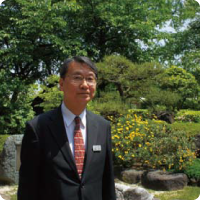- Notice
Teacher's spirit of research fosters students' spirit of inquiry
2013.11.19
Mukogawa Women's University Junior & Senior High School Dr. Masataka Sakamoto
Sakamoto says, "What makes this school unique is that the teachers work with students on topics of their own interest." So far, he says, he has worked on themes such as dye-sensitized solar cells, the 3Rs for extracting gold from computers, and memory materials held by planaria. One of his current research topics of interest is the relationship between ultraviolet light and plants.

UV light is used for photosynthesis!
Ultraviolet rays may have a strong image of being harmful. However, I thought it was impossible that plants would not use ultraviolet rays, which have high energy levels, for photosynthesis, and I searched for such plants. I found a plant that breathes less when exposed to ultraviolet light in the dark than when not exposed to ultraviolet light. That plant is the cherry tree.
As for the cause of reduced respiration, an expert might simply attribute it to the inhibition of respiration by ultraviolet light. However, the professor's group has hypothesized that cherry trees photosynthesize with ultraviolet light. Since a pigment called coumarin, which cherry trees possess, absorbs ultraviolet rays, they are conducting research on the possibility that this coumarin may be involved. The teacher is more excited than the students, saying, "We may make a new discovery from an outsider's point of view.
One theme for three years
At the beginning of April each year, second- and third-year students give a presentation to first-year high school students introducing their group's research. during the first semester of the first year, students decide on one of about 20 themes, and each student basically works on the same theme for three years. In the third year, each student has two hours a week to write a graduation thesis and present it to the class in February. It is truly a research-intensive three years. The professor says that he tries to have an event about once a year to invigorate the group. In the case of dye-sensitized solar cells, neither the students nor I knew much about dyes, so we visited a university professor who taught us how to extract dyes for a day," he says.
Do your own research with your students.
He says, "Research in the middle of one's specialty is not very interesting because one can see what is coming next. In college, he specialized in crop science and studied the photoperiodicity of barley, but ultraviolet light is not his area of expertise. I don't know much about it, but I have always been interested in it. Ultraviolet rays are interesting. Both teacher and students study from the same perspective, discussing and advancing their research through trial and error. The students are finding things I didn't know existed," he says. It seems that the teacher's own inquisitiveness has sparked the students' spirit of inquiry.
Article in the June 2013 issue of Kyoiku Ouen, a science education information magazine
Affiliations are current at the time of publication in Education Support.
